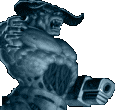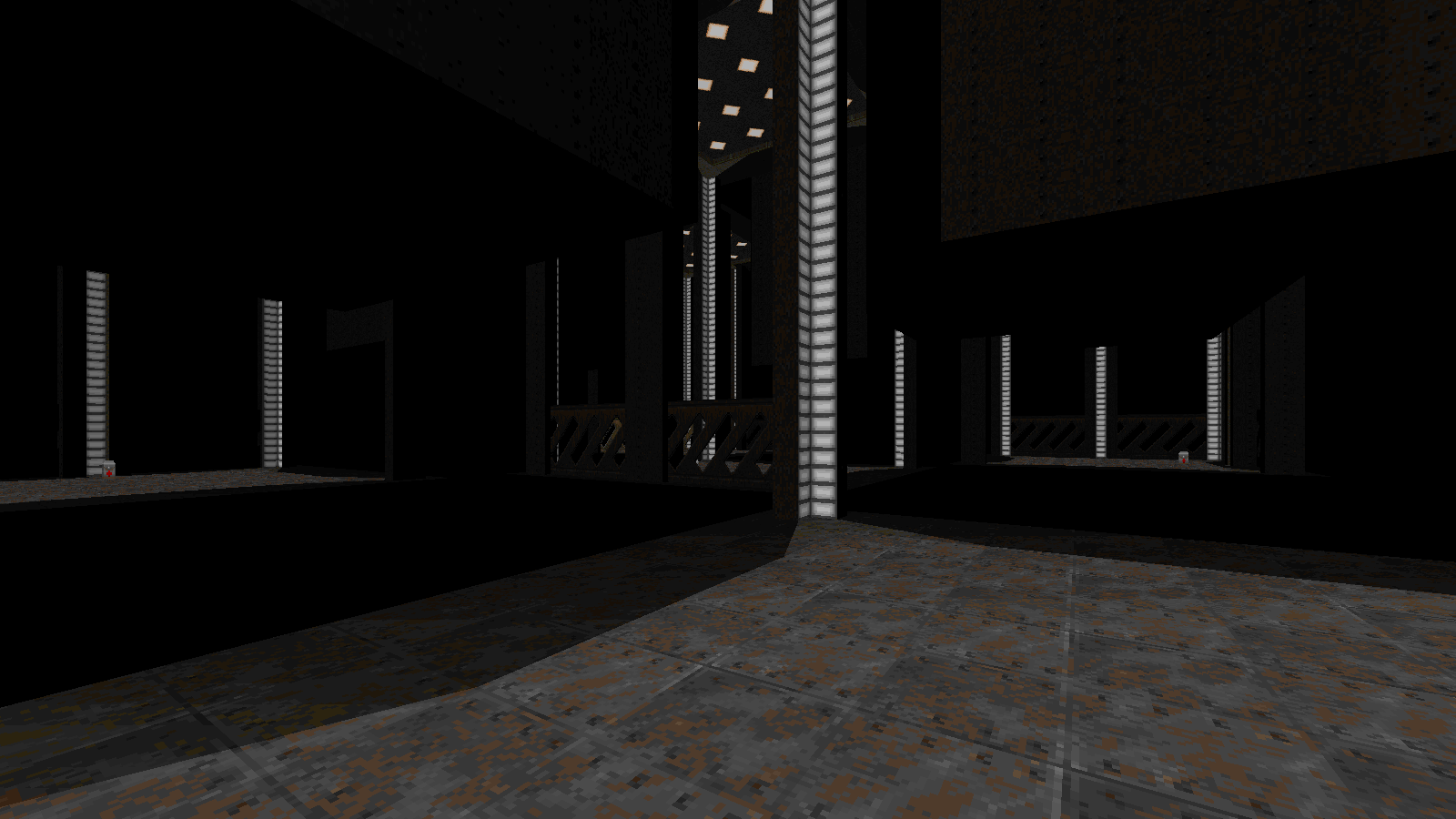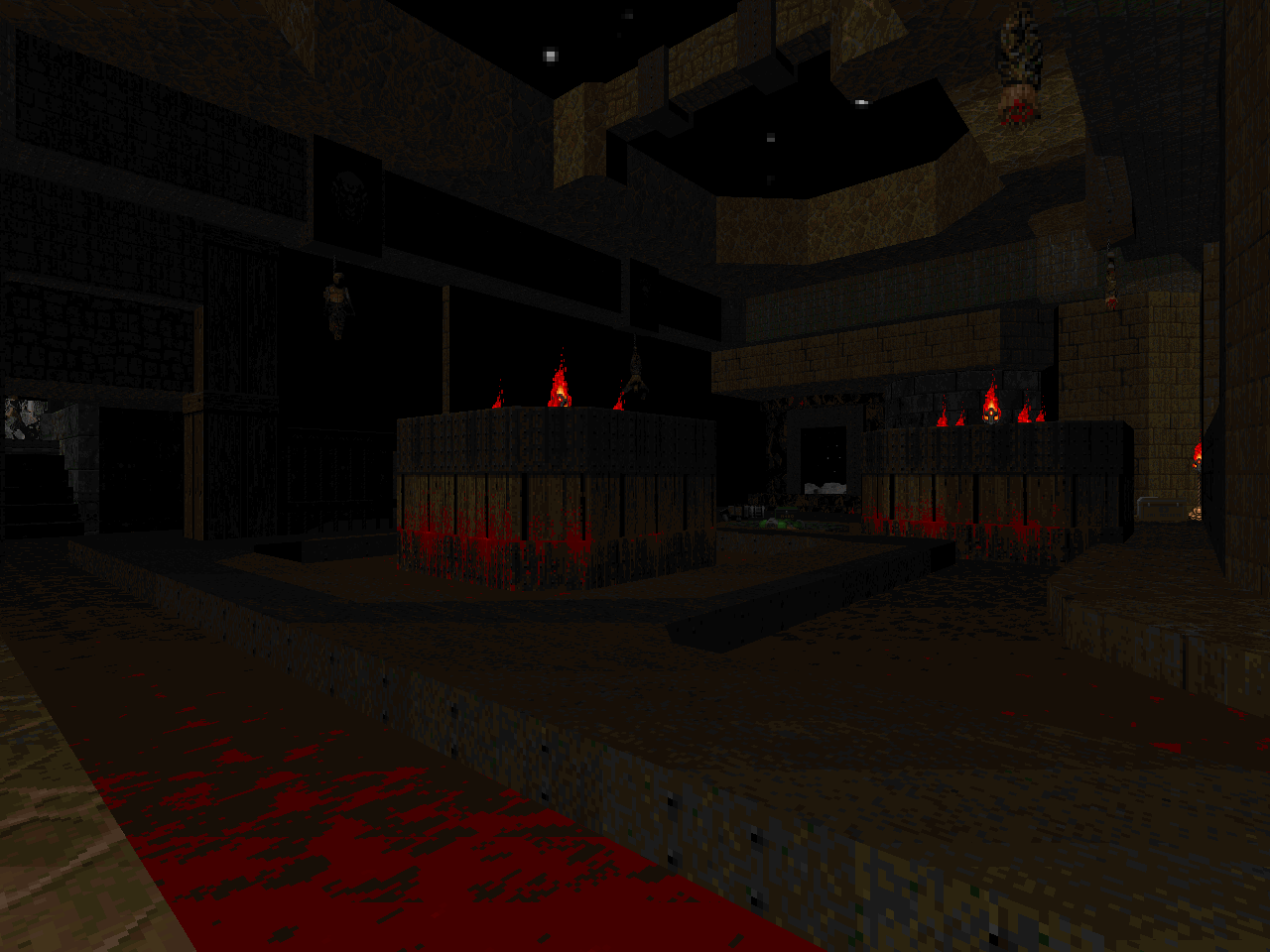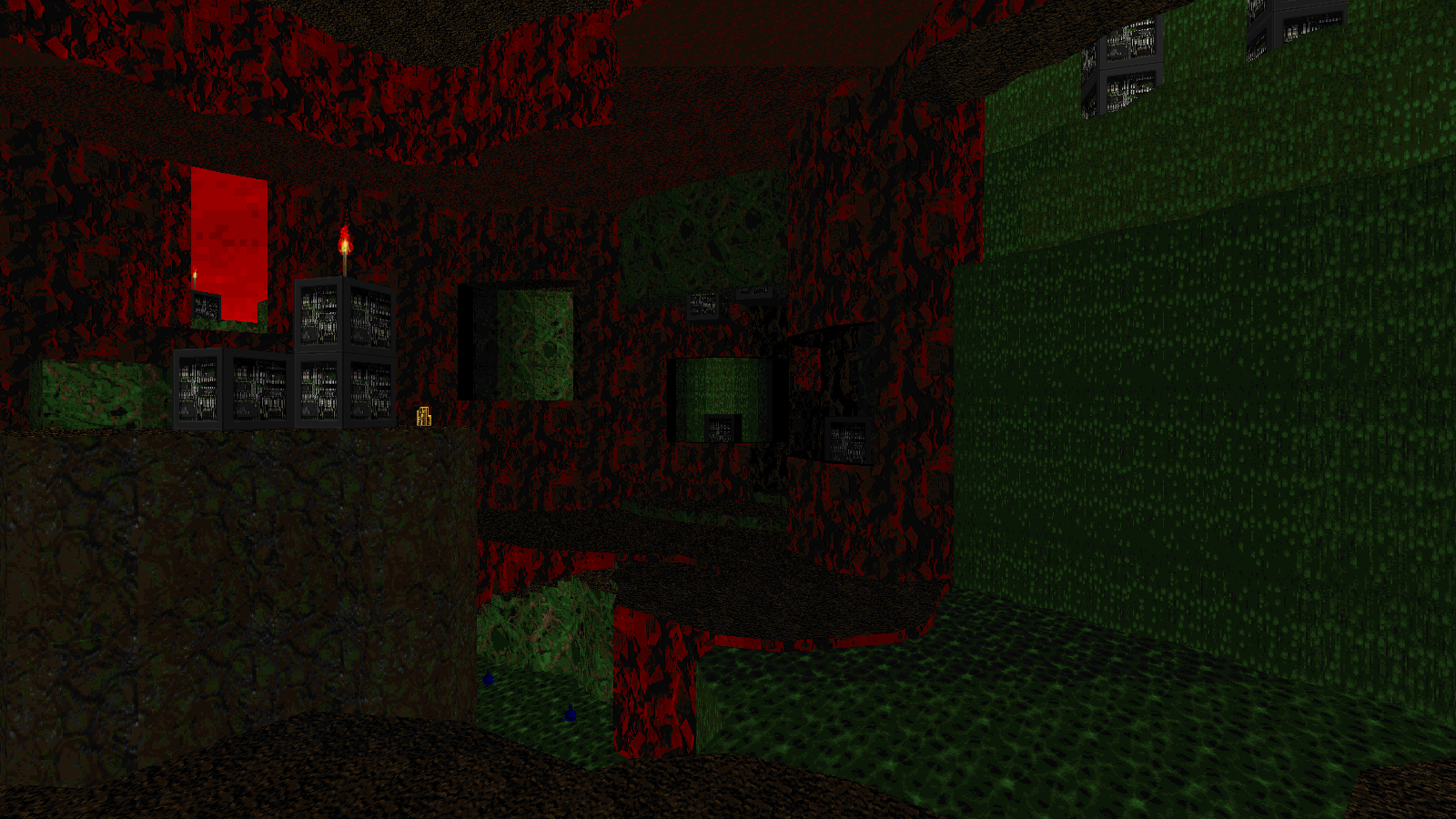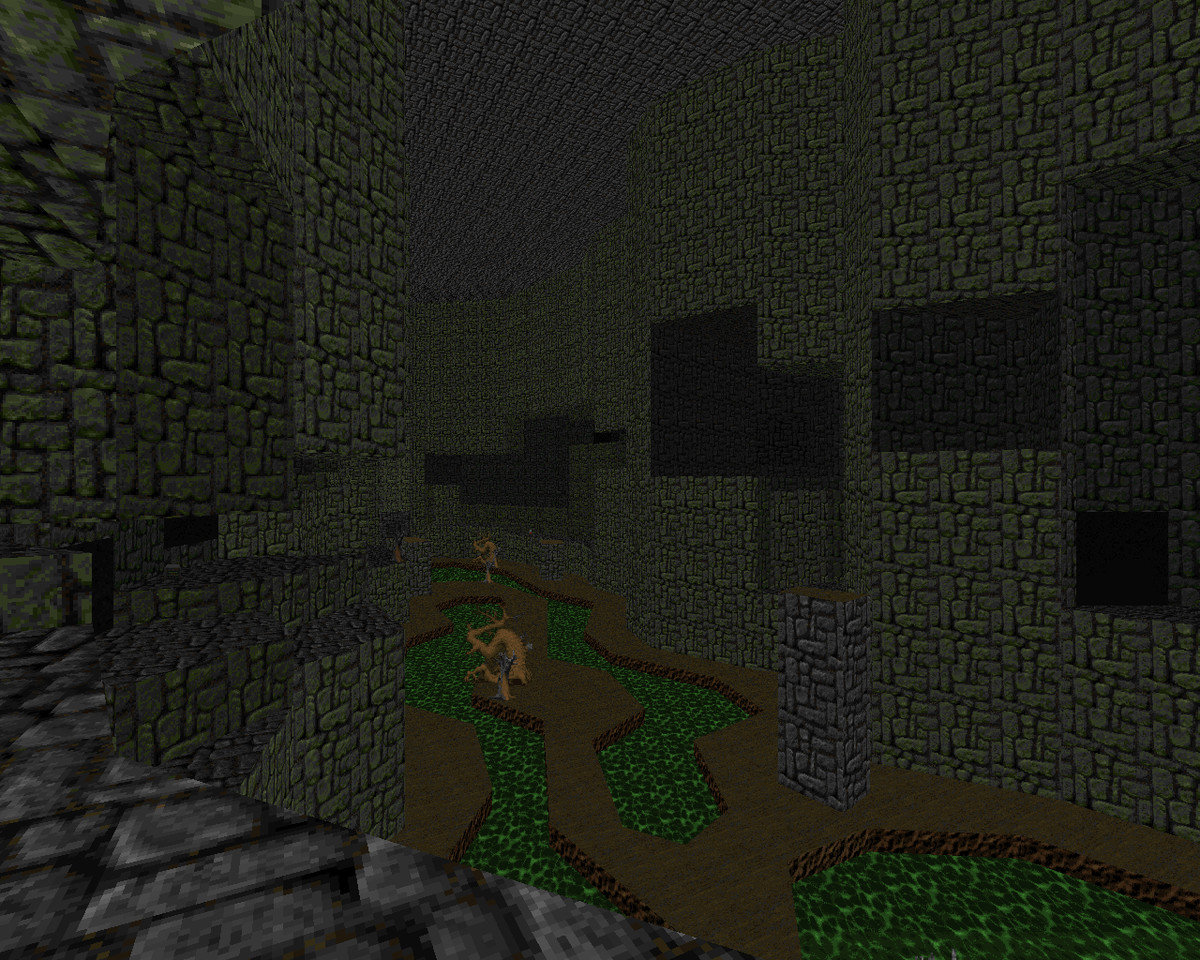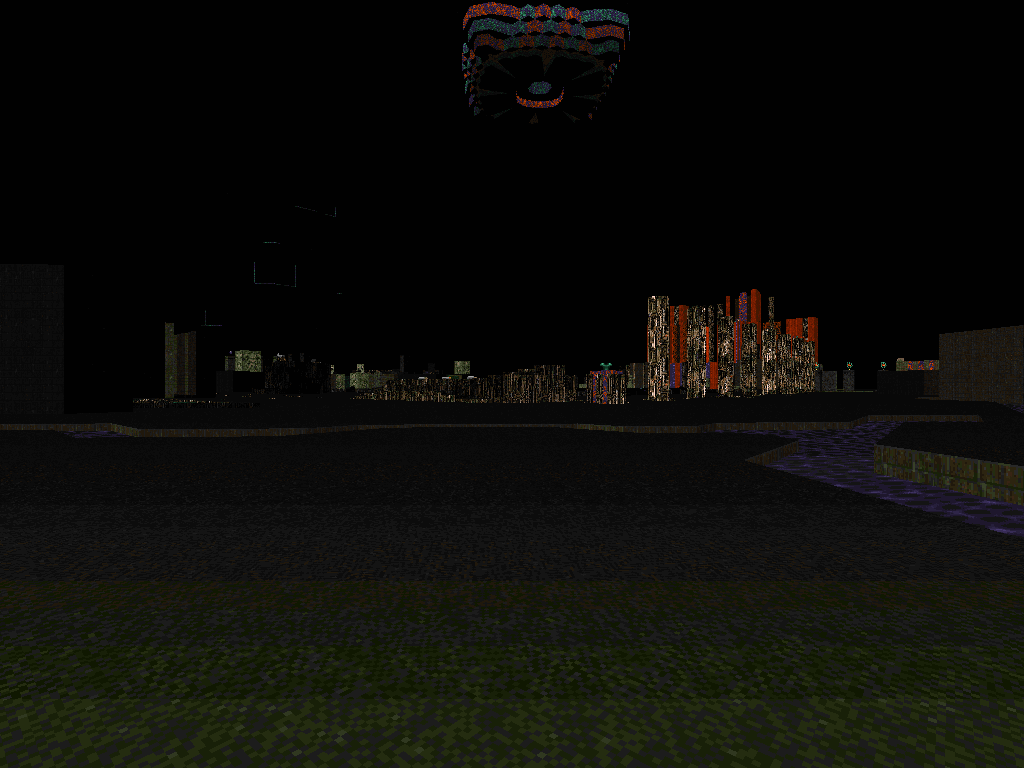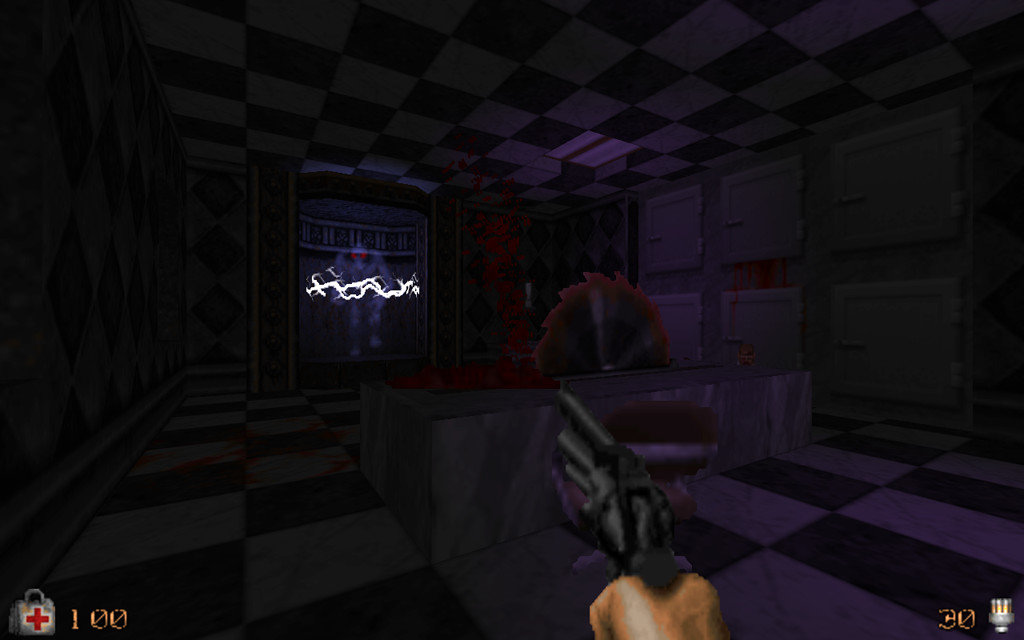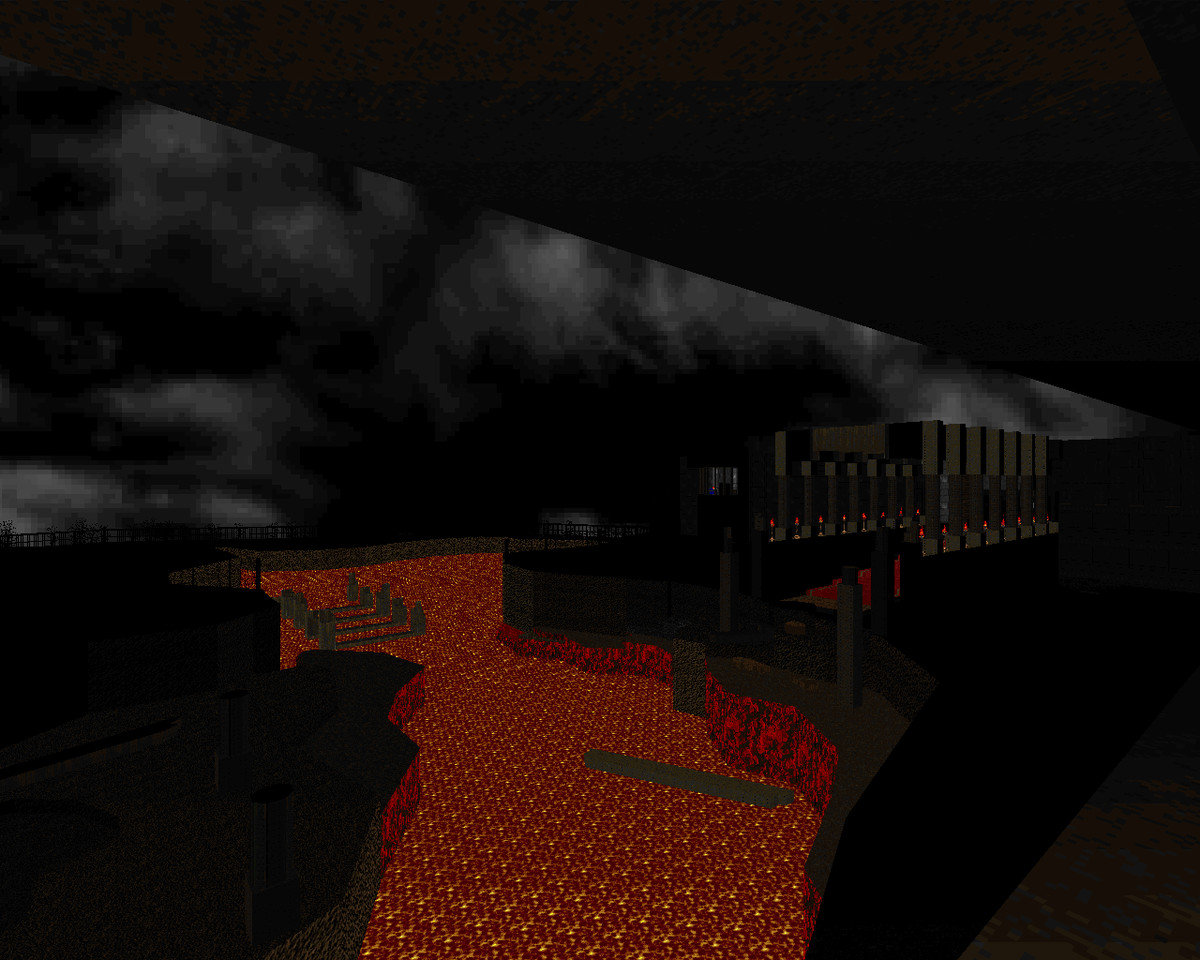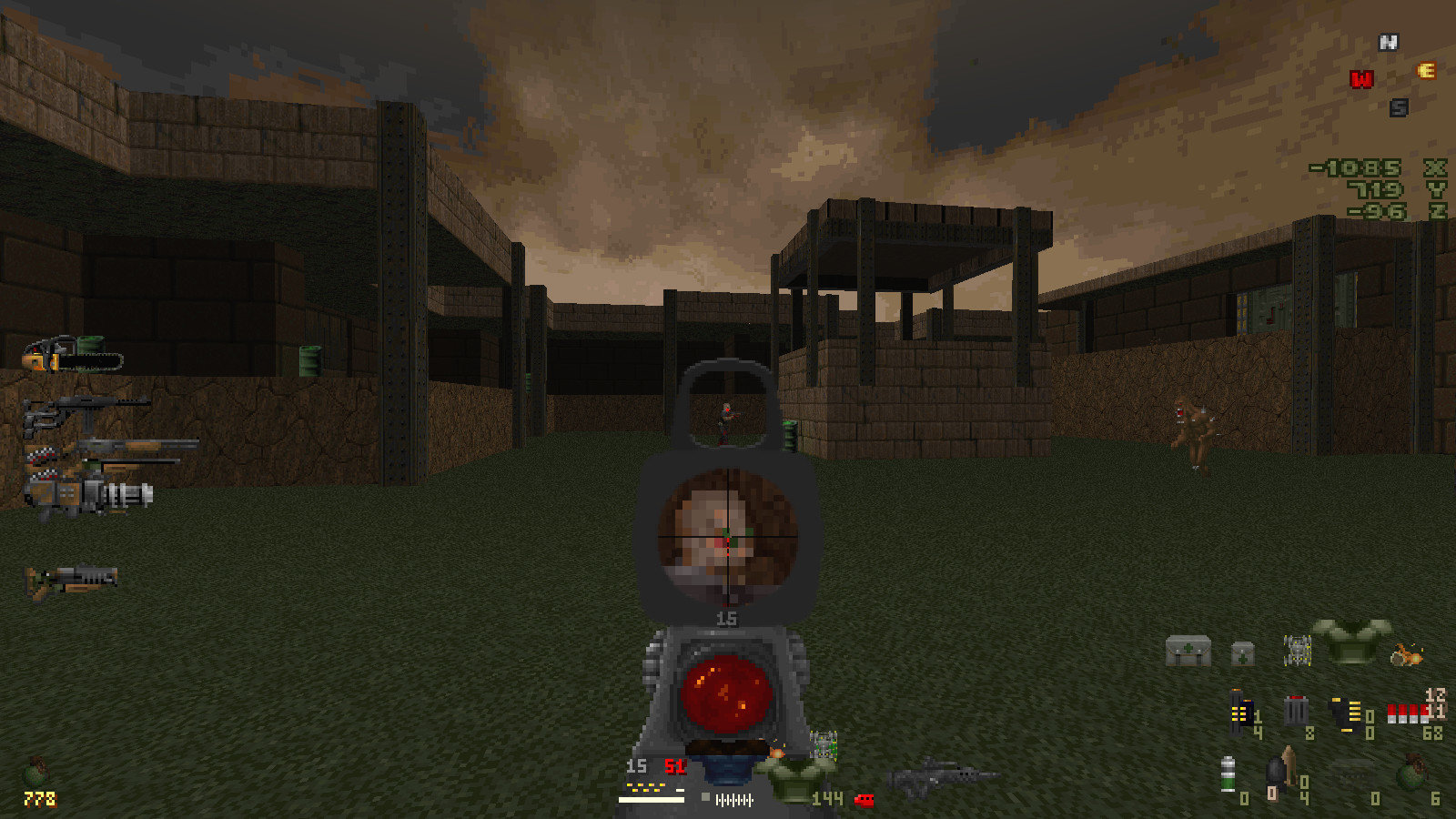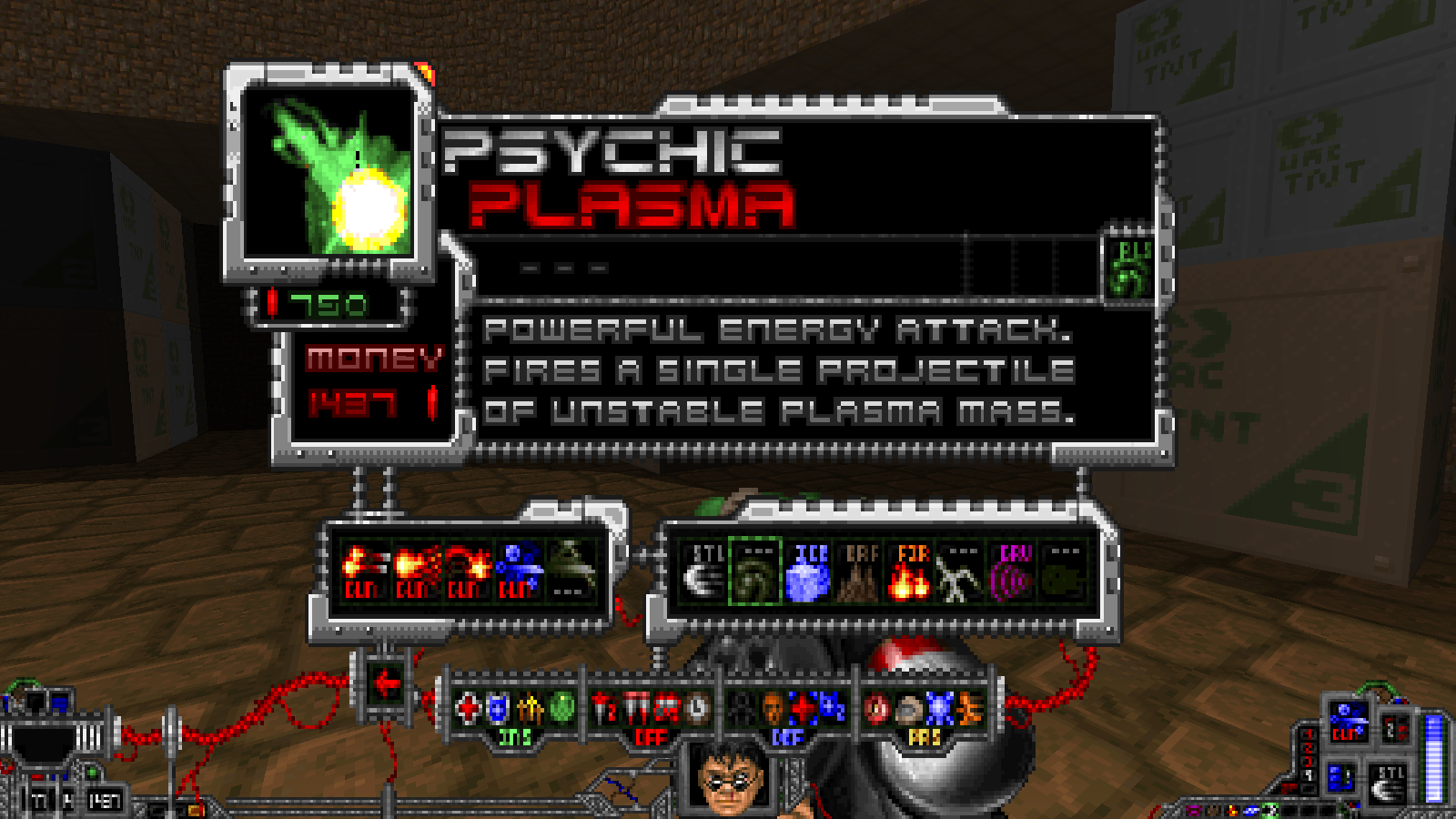-
 Vile Flesh - Gwyn Williams (2004)
Vile Flesh - Gwyn Williams (2004)
Originally released in 2004, Vile Flesh is a fine solo megaWAD in a fine classical tradition, following the journey of a lone soldier over the course of 32 maps as he fights through a beleaguered Earth, the netherworld, and back again in a bid to foil Hell's latest genocidal machinations and, once again, save our world. Lovingly and carefully realized, nicely polished, and decked out with a cool, laid-back custom soundtrack of the author's own making, Vile Flesh was nevertheless somewhat overlooked in its own time (and is now probably most accurately termed a 'cult classic'). Lacking any particular gimmick, obviously esoteric design concept, or other "angle" of note, the WAD's straightlaced, very traditional bent was perhaps not really in vogue as regards the zeitgeist of its own time. Closer examination, however, reveals a game with a confident, coherent, and personal approach to level design, one sure to appeal especially to players inclined to "stop and smell the roses", if you will.
Williams cites Eternal Doom in particular as a reference/influence, and while this is broadly true as far as the scope/scale of many of the levels is concerned, the style is really quite his own. Using only stock textures, the WAD excels at creating a sense of place in each and every one of its maps. No two share the same theme (though E1 is a host of 11 distinctly different "techbase" interpretations, granted), with settings ranging from the highly representational to the purely abstract, but most often inhabiting a comfy midpoint somewhere between. Many of these are highly imaginative regardless of era--a pitch-black subterranean expanse lit only by banks of fluorescents, a Hell of floating guard towers and other sky-islands, a "meat" processing plant floating in a sea of blood--and even the more familiar tend to have a novel spin on them, ala a derelict cathedral where the only way out is a rite of self-sacrifice. Each level is expansive and positively mined with some of the cleverest secrets I've seen in 20+ years of Dooming, making for a leisurely sojourn down what has historically been a road less traveled.
 The Warlock's Hearth - Khorus (2015)
The Warlock's Hearth - Khorus (2015)
Adam Woodmansey earned something of a reputation as a producer of short, hard popcorn levels due to KSSHT in 2011. There's far more depth in his wheelhouse if you glance through his catalogue, though, and he proved it again in 2015 with The Warlock's Hearth. It's one single map but the scope of your adventure is enormous. As the player, you escape the death of your own world by travelling through one of the invasion portals back to its source, finding a dimensional nexus in the titular manse.
While you explore and battle the Warlock's former servants you'll undertake lengthy excursions to other, distinct universes. WARLH has a slow but steady ramp up in its difficulty and while its somewhat open-ended layout may lead you to find out that you aren't entirely prepared for the direction that you're pushing in it rarely if ever gets so crazy that you can't regroup and find another way. Perhaps my favorite detail is the trippy, atmospheric soundtrack courtesy of Der Wolfmensch. It's the perfect topper for this otherworldly journey.
2015 was yet another crazy year of PWAD releases and our picks were pretty much locked in by the time that The Warlock's Hearth had its full, official release. I didn't play it myself until a little after the Cacowards were published. I would rather have so many quality releases that it becomes a burden to keep up with and qualify them, though, than so few that the community might as well be dead.
- @kmxexii
 Plutonium Winds - Darkreaver (2014)
Plutonium Winds - Darkreaver (2014)
Released in November 2013 (i.e. right in the fuzzy, hectic cutoff period between one Cacoward 'season' and the next), there is no particular mea culpa story for this gem, which if nothing else speaks to how difficult it can be to keep track of everything when the greater community is so consistently fruitful in its output. Something of a side-project to the much anticipated/much mourned megaWAD Revelations of Doom, Plutonium Winds features seven short but very intense maps for the Plutonia IWAD, occupying slots 12-18 (presumably for the sky).
The Plutonia Experiment itself is, of course, popularly remembered as "the one with a lot of big monsters", though any WAD-scholar worth his/her salt could tell you that, by and large, action in Plutonia tends to be driven by relatively small numbers of monsters, efficiently placed for maximum effect, rather than by strength of numbers per se. The odd obvious outlier aside (i.e. "Go 2 It", etc.), Plutonia asserts its challenge through consistently creating multiple angles of attack and never allowing areas to become combat-static for long, requiring players to engage tactically but also actively in order to survive/thrive.
Darkreaver's maps in PW show a strong understanding of this concept, but with a personal spin that really ratchets up the intensity several notches. The maps themselves are generally quite small but often very kinetic, undergoing major structural transformations at one or more points, which in turn feeds into the ever-accelerating sense of violence and urgency prosecuted by the waves of demonic denizens inhabiting each. The author's range of gameplay mastery over this relatively short span is remarkable: the least populous map, the sinister rocket-weathered "Memories of Blood" fields 40-some monsters, while the most populous, the violent alpha/omega dovetail of "Salvation by Extermination" fields several hundred; despite this disparity, these two maps, and indeed each and every one of the others, communicate a similarly intoxicating sense of giddy grindhouse escalation, fights which start hot and spiral just past the point of reasonable control, sometimes steadily, sometimes in a necksnapping jolt. This modern, chaotic fluidity married to the classic hardnosed Plutonia style proves to be a match made in the pits of Hell, in the best way possible.
 Alpha 1 Trilogy - Rob Schweiner (1998)
Alpha 1 Trilogy - Rob Schweiner (1998)
The Alpha 1 Trilogy has its roots in 1994 with the release of its second level, OOZI, but it wasn't completely available until 1998, when the community was well into its love affair with Quake. Some were looking to make up for the perceived shortcomings of idtech1 through painstaking detailing and lighting or vanilla trickery and, beginning with the source port Boom, adding engine features that would make Doom feel less archaic. ALPHA1 is not a representation of this sentiment. It is a reflection of one of the core values that continues to bring the community back to drink from its own well.
Schweiner's levels are large for their time and reward the player for exploring them with a plethora of architecturally attractive and distinct areas. The general progression is from the base's top level and through its bowels until you are deep below at the source of the demonic invasion. Each set piece is a memorable experience thanks to the author's elegant architecture and theming. Their associated encounters can be tough but aren't too far removed from the Doom II experience. You get a sense of the author's careful combat design at the very onset, where a single shot causes the entire base to organically erupt into an ambush.
ALPHA1 is a solid, polished set that perfectly encapsulates the best aspects of Doom's golden age level design, when every map felt like a tiny world unto itself and the sheer novelty of exploring them all had yet to wear off.
- @kmxexii
 Toilet of the Gods - Benjogami (2016)
Toilet of the Gods - Benjogami (2016)
A common misconception endures that the slaughter mapping scene is a few important luminaries -- most recognizably, Ribbiks and Danne -- hovering high above a heap of amateurs producing slavish imitations under their guiding light. The output of 2015 onward demonstrates this to be an outdated notion. The new crop is roughly as talented as their celebrity predecessors, bringing no shortage of their own rich, original, and well-wrought ideas. One of the highlights of this recent surge came about in the middle of 2016, when Benjogami splashed into the scene (insert obvious toilet pun).
Toilet of the Gods is a stellar four-map set whose modus operandi is lengthy slaughter fights situated in topographically complex spaces, usually with a lot of moving parts to juggle at once. Each of the main maps plays off of that core focus by throwing different primary concept into the mix: map01 with its precarious platforming; map02 with its "pick your poison" approach to handling each area; and map03 with its sandbox structure and emphasis on macro-routing. The visuals are eccentric and sleek, scenes out of a drug trip: a wild palette shift, crazy light effects, and emphasis on shape and architecture over fine-grained detail. Benjogami was kind enough to implement difficulty settings, and I'd highly suggest you start out on HNTR -- which is already more difficult than most conventional releases are on UV -- unless you are (a) already familiar enough with the genre to know you can handle more, or (b) seeking to punish yourself but misplaced your whips and restraints.
- @rd.
 DemoniZed - NokturnuS (1998)
DemoniZed - NokturnuS (1998)
I first played this two-map set shortly after I came to the Doom community, and for many years I was under the mistaken assumption that they were ZDoom maps from circa 2003 due to the use of advanced features and the quality and detail of the level design. When I finally realized they were Boom maps from 1998, it blew my mind. I guess that just goes to show how far ahead of its time DemoniZed was.
The action is somewhere between Plutonia and Hell Revealed on a city-wide scale, with a map 01 start that puts you out of your league against the tougher denizens of the hellish town with just a shotgun and pressures you into hunting for something better. It never quite lets up, using a combination of limited space and high enemy counts to keep the player from falling into too much of a comfort zone, and then map 02 goes all-out (for 1998) with constant action and a barrage of enemy fire from every corner in a way that perhaps foreshadows proto-modern mappers like Erik Alm, Anders Johnsen, and Huy Pham. But realistically, this is a 1998 map and modern players can handle it without dire stress – and it’s worth seeing for the memorable pre-ZDoom effects, like dropping down into a previously visited area from above or the dramatically “scripted” sequencing of the flesh lifts in the backpack room.
 City of the Damned: Apocalypse - Tormentor667 (2007)
City of the Damned: Apocalypse - Tormentor667 (2007)
While the original City of the Damned was essentially an action-oriented map with lots of advanced features for the time, Tormentor took a very different path for the sequel, focusing on atmosphere, tension, and survival horror gameplay elements. The result is one of the most fully realized horror maps that’s ever been made for Doom. Taking place in and around the large, eerily quiet city, the map encourages you to be cautious but is ultimately open and sandboxy, with your playstyle and route choice dictating how quickly you can get better weapons that make the going easier. After you reach a certain point in the progression, you’ll also have to keep an ear open for the sirens, which force you to take cover in designated Moon Shelters or face overwhelming odds.
CotD:A was perhaps the most ambitious and impressive snub of the 2000s, and there are reasons not everyone is a fan. The slower, story-oriented pacing and cover-based, sometimes hitscan-heavy combat style don’t appeal to many people who prefer Doom’s arcadey style, and boss battles can be frustrating and sometimes come out of nowhere. Generally, though, if you remember to save periodically and don’t waste ammo on melee enemies, you won’t put yourself at any great risk of suffering. Anyone who’s got an interest in survival horror, or loves seeing what Doom can do when it’s treated as a totally different game, would do well to give this one a try with the lights off.
 Sacrament by Clan [B0S] (2011)
Sacrament by Clan [B0S] (2011)
A.L.T. is also on this list but I believe that the Russian Doom community's first watershed moment was the release of Sacrament in 2011. If I were to generalize its character, the RDC pre-Clan [B0S] was largely focused on speedmapping events outside of isolated auteurs like Eternal and Shadowman. SACRMENT showcased the greater depth of its talent in a way that celebrated its raw imagination. Sometimes it's the dark wonder of exploring a post-apocalyptic universe in Lainos's "Doxylamine Moon" and BeeWen's "Controlled System", also a common theme in the former's following works. At others it's the feeling of high adventure when you get your first view of the massive grotto in Azamael's "Seaport" or the graveyard / spirit world journey in "Vancouver", by Archi.
I may have helped to cement the term "Russian realism" to characterize the RDC's output but the true common thread that runs through their works is not the fidelity they pursue in representing real-world locations but the effort spent in meticulously rendering the conjurations of their artistic vision. For authors like Wraith this comes through in painstaking re-imaginations of beloved works such as Wonderful Doom and I assume "Lavatraz" within Sacrament itself. These efforts feel largely unfiltered or unfettered by concessions made toward the player but when I do see something like the otherwise featureless automap route in MAP02 I remember that it was added after the fact to serve those players who have no passion for exploring these virtual fantasies.
- @kmxexii
 Hideous Destructor by Vaecrius (2007)
Hideous Destructor by Vaecrius (2007)
Hideous Destructor is a name that inspires fear in many Doom players, confusion in others, and awe in yet others, and is one of the longest-developed gameplay mods in Doom history. It's a perpetually changing and ever-expanding beast of a project, which alone is pretty impressive; development started in 2007 and production has continued for over 10 years without any significant haitus. It's not the same mod today as it was when it started, it's not the same as it was a year ago, and it sure as hell won't be the same in the future.
While a lot of gameplay mods tend to get criticized for making the base game easier, Hideous Destructor is an interesting little anomaly. It's an extremely technical and tactical mod, and nearly every system is completely unlike base Doom. You go from a projectile-dodging-gun-shooting-whizz-bang festival to a puzzle game where you need to manage more than you would ever think reasonably possible--the physical presence of your weapons (guns can bump against walls), your inventory and total pocket space (you can't carry a backpack and everything), the interactions between health and armor (you can bleed out and only medikits can completely stop it, but you can't apply medicine with your armor on), and even your damn heart rate (by the way, you can die from a heart attack). This isn't even getting into the enemies, which are terrifying and actively malevolent. If you thought Archviles were annoying before...
Hideous Destructor is one of the few gameplay mods to come with a dedicated manual, and for once in video game history it is absolutely required reading. But while it would be easy to dismiss it as simply "hard for the sake of being hard", to do so would be a huge disservice to a truly unique mod. As with every puzzle game, you are presented a problem and there needs to be thinking and planning about how to overcome it. Very few scenarios in Hideous Destructor end up being truly impossible, there simply needs to be a lot of tactics about how to overcome things. The name of the game is not so much about winning as it is simply surviving, and how you do that is up to you.
Just don't play it on Chillax.
 Psychic by Xaser (2009)
Psychic by Xaser (2009)
Xaser has a habit of accidentally revolutionizing the community. There's no need to mince words, Psychic is one of the definitive gameplay mods for Doom. Released in 2009, Psychic is nearly 10 years old, and to this day Doom still has yet to have another gameplay mod as tightly-focused, approachable, and finetuned as this.
The gameplay revolves around a sort of "dual wielding" set-up reminiscent of the Shock series of games, guns on your primary fire and psychic abilities on your alternate fire. Your guns are standard but have unlimited ammo, while your psychic abilities are powerful but run off a limited supply and can burn you out if you try to use them too low. Kill enemies, get cash, buy stuff, kill enemies with more stuff. With such a simple set-up, however, comes a wide variety of extremely fun abilities. Throwing enemies around with Gravity is a blast, and it sets enemies up for getting nailed with grenades. Launching a series of bouncing razor blades in a crowded room provides a satisfying cacophany of bisecting sound effects, and you can finish off any survivors with a stylish pair of rapid-fire pistols. Swap between guns with the usual next/previous weapons, swap between psychic abilities with your inventory keys, open up a mapset of choice and go to town.
While it's never been "finished", Psychic's lingering impact on the Doom community can still be felt to its day. Everyone was wowed by its extremely smooth animations and streamlined effects, which have since become a common staple. It introduced a shop system with currency and an ACS menu, which many mods have since done their own take on. Nearly every aspect of the mod has been imitated or referenced or expanded on...but to this day, nobody can quite match the bar Psychic has set.
